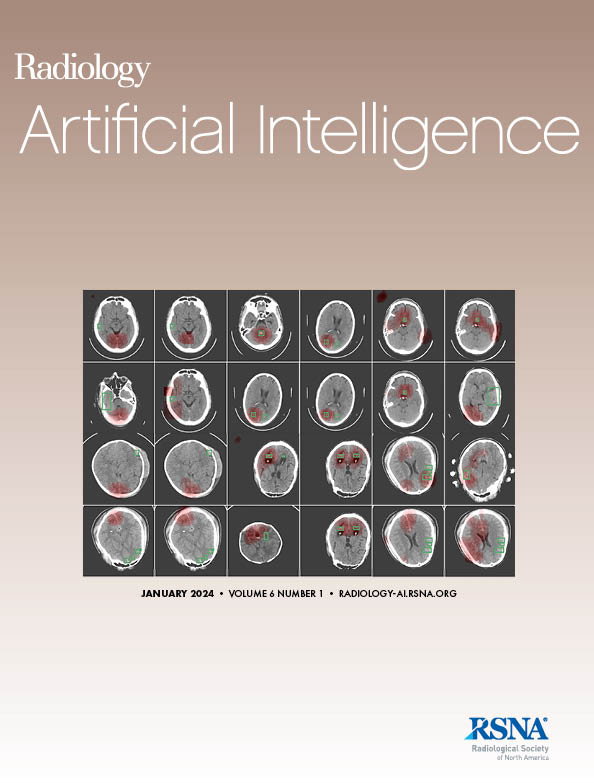Weonsuk Lee, Hyeonsoo Lee, Hyunjae Lee, Eun Kyung Park, Hyeonseob Nam, Thijs Kooi
下载PDF
{"title":"基于变压器的深度神经网络在数字乳腺断层合成图像上的乳腺癌分类。","authors":"Weonsuk Lee, Hyeonsoo Lee, Hyunjae Lee, Eun Kyung Park, Hyeonseob Nam, Thijs Kooi","doi":"10.1148/ryai.220159","DOIUrl":null,"url":null,"abstract":"<p><strong>Purpose: </strong>To develop an efficient deep neural network model that incorporates context from neighboring image sections to detect breast cancer on digital breast tomosynthesis (DBT) images.</p><p><strong>Materials and methods: </strong>The authors adopted a transformer architecture that analyzes neighboring sections of the DBT stack. The proposed method was compared with two baselines: an architecture based on three-dimensional (3D) convolutions and a two-dimensional model that analyzes each section individually. The models were trained with 5174 four-view DBT studies, validated with 1000 four-view DBT studies, and tested on 655 four-view DBT studies, which were retrospectively collected from nine institutions in the United States through an external entity. Methods were compared using area under the receiver operating characteristic curve (AUC), sensitivity at a fixed specificity, and specificity at a fixed sensitivity.</p><p><strong>Results: </strong>On the test set of 655 DBT studies, both 3D models showed higher classification performance than did the per-section baseline model. The proposed transformer-based model showed a significant increase in AUC (0.88 vs 0.91, <i>P</i> = .002), sensitivity (81.0% vs 87.7%, <i>P</i> = .006), and specificity (80.5% vs 86.4%, <i>P</i> < .001) at clinically relevant operating points when compared with the single-DBT-section baseline. The transformer-based model used only 25% of the number of floating-point operations per second used by the 3D convolution model while demonstrating similar classification performance.</p><p><strong>Conclusion: </strong>A transformer-based deep neural network using data from neighboring sections improved breast cancer classification performance compared with a per-section baseline model and was more efficient than a model using 3D convolutions.<b>Keywords:</b> Breast, Tomosynthesis, Diagnosis, Supervised Learning, Convolutional Neural Network (CNN), Digital Breast Tomosynthesis, Breast Cancer, Deep Neural Networks, Transformers <i>Supplemental material is available for this article.</i> © RSNA, 2023.</p>","PeriodicalId":29787,"journal":{"name":"Radiology-Artificial Intelligence","volume":null,"pages":null},"PeriodicalIF":8.1000,"publicationDate":"2023-05-01","publicationTypes":"Journal Article","fieldsOfStudy":null,"isOpenAccess":false,"openAccessPdf":"https://www.ncbi.nlm.nih.gov/pmc/articles/PMC10245183/pdf/ryai.220159.pdf","citationCount":"1","resultStr":"{\"title\":\"Transformer-based Deep Neural Network for Breast Cancer Classification on Digital Breast Tomosynthesis Images.\",\"authors\":\"Weonsuk Lee, Hyeonsoo Lee, Hyunjae Lee, Eun Kyung Park, Hyeonseob Nam, Thijs Kooi\",\"doi\":\"10.1148/ryai.220159\",\"DOIUrl\":null,\"url\":null,\"abstract\":\"<p><strong>Purpose: </strong>To develop an efficient deep neural network model that incorporates context from neighboring image sections to detect breast cancer on digital breast tomosynthesis (DBT) images.</p><p><strong>Materials and methods: </strong>The authors adopted a transformer architecture that analyzes neighboring sections of the DBT stack. The proposed method was compared with two baselines: an architecture based on three-dimensional (3D) convolutions and a two-dimensional model that analyzes each section individually. The models were trained with 5174 four-view DBT studies, validated with 1000 four-view DBT studies, and tested on 655 four-view DBT studies, which were retrospectively collected from nine institutions in the United States through an external entity. Methods were compared using area under the receiver operating characteristic curve (AUC), sensitivity at a fixed specificity, and specificity at a fixed sensitivity.</p><p><strong>Results: </strong>On the test set of 655 DBT studies, both 3D models showed higher classification performance than did the per-section baseline model. The proposed transformer-based model showed a significant increase in AUC (0.88 vs 0.91, <i>P</i> = .002), sensitivity (81.0% vs 87.7%, <i>P</i> = .006), and specificity (80.5% vs 86.4%, <i>P</i> < .001) at clinically relevant operating points when compared with the single-DBT-section baseline. The transformer-based model used only 25% of the number of floating-point operations per second used by the 3D convolution model while demonstrating similar classification performance.</p><p><strong>Conclusion: </strong>A transformer-based deep neural network using data from neighboring sections improved breast cancer classification performance compared with a per-section baseline model and was more efficient than a model using 3D convolutions.<b>Keywords:</b> Breast, Tomosynthesis, Diagnosis, Supervised Learning, Convolutional Neural Network (CNN), Digital Breast Tomosynthesis, Breast Cancer, Deep Neural Networks, Transformers <i>Supplemental material is available for this article.</i> © RSNA, 2023.</p>\",\"PeriodicalId\":29787,\"journal\":{\"name\":\"Radiology-Artificial Intelligence\",\"volume\":null,\"pages\":null},\"PeriodicalIF\":8.1000,\"publicationDate\":\"2023-05-01\",\"publicationTypes\":\"Journal Article\",\"fieldsOfStudy\":null,\"isOpenAccess\":false,\"openAccessPdf\":\"https://www.ncbi.nlm.nih.gov/pmc/articles/PMC10245183/pdf/ryai.220159.pdf\",\"citationCount\":\"1\",\"resultStr\":null,\"platform\":\"Semanticscholar\",\"paperid\":null,\"PeriodicalName\":\"Radiology-Artificial Intelligence\",\"FirstCategoryId\":\"1085\",\"ListUrlMain\":\"https://doi.org/10.1148/ryai.220159\",\"RegionNum\":0,\"RegionCategory\":null,\"ArticlePicture\":[],\"TitleCN\":null,\"AbstractTextCN\":null,\"PMCID\":null,\"EPubDate\":\"\",\"PubModel\":\"\",\"JCR\":\"Q1\",\"JCRName\":\"COMPUTER SCIENCE, ARTIFICIAL INTELLIGENCE\",\"Score\":null,\"Total\":0}","platform":"Semanticscholar","paperid":null,"PeriodicalName":"Radiology-Artificial Intelligence","FirstCategoryId":"1085","ListUrlMain":"https://doi.org/10.1148/ryai.220159","RegionNum":0,"RegionCategory":null,"ArticlePicture":[],"TitleCN":null,"AbstractTextCN":null,"PMCID":null,"EPubDate":"","PubModel":"","JCR":"Q1","JCRName":"COMPUTER SCIENCE, ARTIFICIAL INTELLIGENCE","Score":null,"Total":0}
引用次数: 1
引用
批量引用
Transformer-based Deep Neural Network for Breast Cancer Classification on Digital Breast Tomosynthesis Images.
Purpose: To develop an efficient deep neural network model that incorporates context from neighboring image sections to detect breast cancer on digital breast tomosynthesis (DBT) images.
Materials and methods: The authors adopted a transformer architecture that analyzes neighboring sections of the DBT stack. The proposed method was compared with two baselines: an architecture based on three-dimensional (3D) convolutions and a two-dimensional model that analyzes each section individually. The models were trained with 5174 four-view DBT studies, validated with 1000 four-view DBT studies, and tested on 655 four-view DBT studies, which were retrospectively collected from nine institutions in the United States through an external entity. Methods were compared using area under the receiver operating characteristic curve (AUC), sensitivity at a fixed specificity, and specificity at a fixed sensitivity.
Results: On the test set of 655 DBT studies, both 3D models showed higher classification performance than did the per-section baseline model. The proposed transformer-based model showed a significant increase in AUC (0.88 vs 0.91, P = .002), sensitivity (81.0% vs 87.7%, P = .006), and specificity (80.5% vs 86.4%, P < .001) at clinically relevant operating points when compared with the single-DBT-section baseline. The transformer-based model used only 25% of the number of floating-point operations per second used by the 3D convolution model while demonstrating similar classification performance.
Conclusion: A transformer-based deep neural network using data from neighboring sections improved breast cancer classification performance compared with a per-section baseline model and was more efficient than a model using 3D convolutions.Keywords: Breast, Tomosynthesis, Diagnosis, Supervised Learning, Convolutional Neural Network (CNN), Digital Breast Tomosynthesis, Breast Cancer, Deep Neural Networks, Transformers Supplemental material is available for this article. © RSNA, 2023.

 求助内容:
求助内容: 应助结果提醒方式:
应助结果提醒方式:


